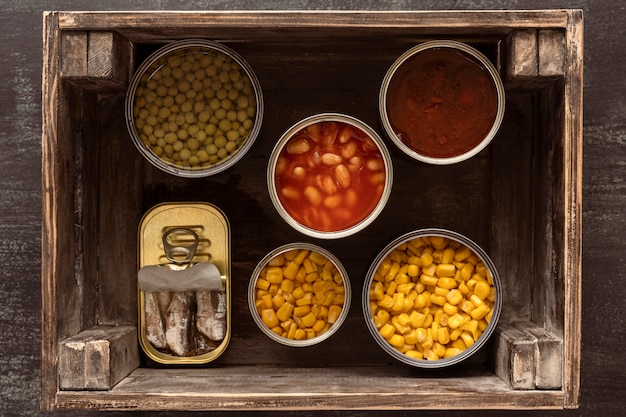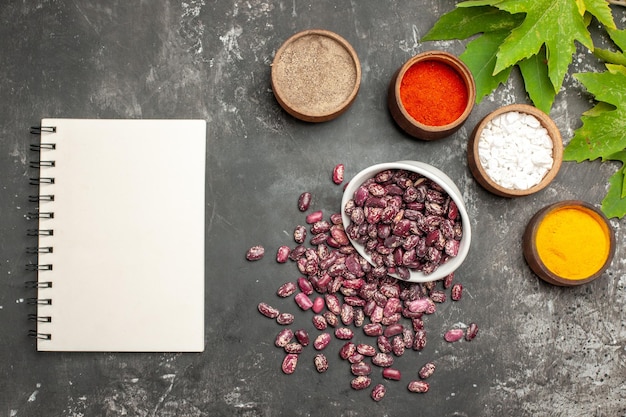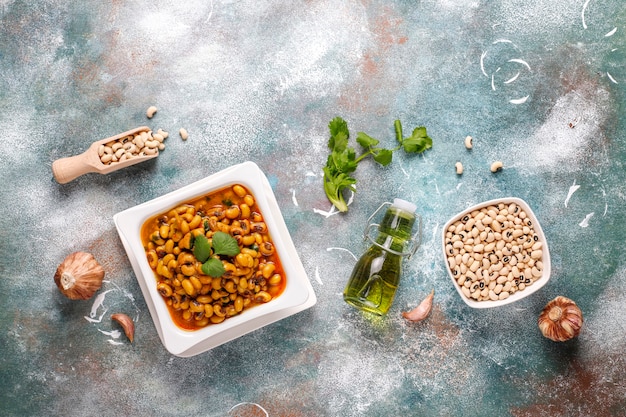Let's be honest, beans are a bit of a culinary chameleon. They can be the star of the show, a supporting character, or even a humble side dish. But regardless of their role, they're always a welcome addition to any meal.
However, cooking perfect beans isn't just about throwing them in a pot and hoping for the best. It's about understanding their quirks, mastering a few techniques, and embracing the art of experimentation.
So, you want to know how to cook the perfect beans? Well, grab a cuppa, settle in, and let's embark on this culinary adventure together.
(Part 1) Choosing the Right Beans: A Bean for Every Mood

The world of beans is incredibly diverse, with each type offering a unique flavour and texture. Choosing the right bean is the first step towards culinary bliss.
Navigating the Bean Universe: Common Types and Their Uses
- kidney beans: These hearty beans are the heart and soul of chili con carne. They hold their shape well, making them ideal for salads and dips. Their bold flavour adds a punch to vegetarian dishes.
- butter beans: These creamy, buttery beans are perfect for a comforting soup or a delicate bean salad. Their subtle sweetness complements both savory and sweet dishes.
- black beans: A staple in Mexican cuisine, black beans shine in black bean salsa, vegetarian burgers, and hearty stews. They have a slightly earthy flavour and a firmer texture.
- cannellini beans: These large, white beans are a culinary chameleon. They lend a silky smoothness to pasta sauces, add substance to salads, and contribute a subtle sweetness to soups.
- Chickpeas: Also known as garbanzo beans, these versatile legumes are a pantry staple. They add a nutty flavour and a satisfying texture to salads, curries, and dips like hummus.
- pinto beans: These speckled beans are a cornerstone of Mexican cuisine. They're delightful in burritos, tacos, and even as a base for hearty vegetarian chili.
- borlotti beans: These beautiful, mottled beans add a touch of elegance to any dish. Their subtle sweetness and firm texture make them perfect for stews, salads, and even pasta dishes.
- haricot beans: These small, white beans are best known for their role in soups and stews. They contribute a subtle flavour and a creamy texture.
Fresh or Dried? A Matter of Taste (and Time)
You can find beans in both fresh and dried forms. dried beans tend to be more affordable and often have a deeper, more intense flavour, but they require soaking and cooking. fresh beans are readily available, require less preparation, and are perfect for a quick meal.
(Part 2) The Art of Soaking: A Crucial Step Towards Culinary Perfection

Soaking your dried beans before cooking is not just a good idea, it's a necessity. It's like giving your beans a mini-spa treatment. It softens the beans, allowing them to cook more evenly and quickly. But the real benefit? Soaking helps reduce the oligosaccharides, those pesky sugars that can cause gas and bloating.
The Overnight Soak: The Gold Standard
Cover your beans with plenty of water, give them a good stir, and let them rest in a cool place for at least 6-8 hours, ideally overnight. This gentle soak allows the beans to absorb moisture and soften up.
The Quick Soak: For When Time is Tight
If you're short on time, a quick soak can save the day. Bring the beans to a boil in a pot of water, then remove them from the heat and let them sit for an hour. It's not as effective as an overnight soak, but it will do the trick in a pinch.
(Part 3) cooking beans on the Stovetop: A Classic Method

The stovetop is a reliable and simple way to cook beans. It allows for a hands-on approach, and you can easily adjust the cooking time and flavour profile to your liking.
The Stovetop Symphony: Step-by-Step Instructions
1. Drain the Beans: Give your soaked beans a good rinse and drain them in a colander.
2. Fresh Water: Fill a pot with fresh water, about 2-3 inches above the beans.
3. Aromatic Infusion: This is where you get to express your culinary creativity. Add onions, garlic, carrots, celery, bay leaves, herbs, and spices that tantalize your taste buds.
4. Bring to a Boil: Bring the water and beans to a rolling boil.
5. Simmer Time: Reduce the heat to low, cover the pot, and let the beans simmer until tender. This can take anywhere from 1-2 hours, depending on the bean type.
6. Salt at the Finish: Salt your beans at the end of cooking. This will help them retain their shape and prevent them from becoming mushy.
(Part 4) The pressure cooker: Your Shortcut to Delicious Beans
If you're a time-conscious cook, a pressure cooker is a game-changer. It drastically reduces cooking time, allowing you to enjoy delicious beans in a fraction of the time.
Pressure Cooker Cooking Times: A Handy Guide
| Bean Type | Pressure Cooker Time (minutes) |
|---|---|
| Kidney beans | 20-30 |
| Butter beans | 25-35 |
| Black beans | 20-30 |
| Cannellini beans | 25-35 |
| Chickpeas | 20-30 |
| Pinto beans | 20-30 |
| Borlotti beans | 25-35 |
| Haricot beans | 20-30 |
Pressure Cooker Magic: Step-by-Step Instructions
1. Rinse Your Beans: Give your beans a thorough rinse under cold water.
2. Pressure Cooker Ready: Put the rinsed beans in the pressure cooker with fresh water, about 2-3 inches above the beans.
3. Aromatic Delight: Add your favorite aromatics – onions, garlic, herbs, spices, or even chopped tomatoes for extra flavour.
4. Seal and Cook: Secure the lid tightly and bring the pressure cooker to high pressure. Cook for the time specified in the table above.
5. Natural Release: Once the cooking time is up, let the pressure release naturally for 10 minutes. This allows the steam to gently reduce the pressure and helps prevent the beans from bursting.
6. Release the Pressure: After 10 minutes, carefully release any remaining pressure.
7. Enjoy! You've got perfectly cooked beans, ready to be used in your favourite dishes.
(Part 5) The slow cooker: Set It and Forget It Bean Bliss
For the ultimate in effortless cooking, a slow cooker is your trusty companion. It's perfect for making large batches of beans, allowing you to set it and forget it while you go about your day.
Slow Cooker Timelines: A Gentle Reminder
Generally, you'll cook your beans in a slow cooker on low heat for 8-10 hours, or on high heat for 4-6 hours.
Slow Cooker Steps: Simplicity at its Finest
1. Rinse Your Beans: Give your beans a good rinse under cold water.
2. Slow Cooker Ready: Put the beans in the slow cooker with fresh water, about 2-3 inches above the beans.
3. Aromatic Infusion: Add onions, garlic, herbs, spices, chopped tomatoes, or even tomato paste for a depth of flavour.
4. Cook to Perfection: Cook on low heat for 8-10 hours, or on high heat for 4-6 hours, until the beans are tender.
5. Enjoy! Your beans are ready to be used in your favourite dishes.
(Part 6) Tips for Achieving Bean Perfection: A Culinary Guide
Cooking perfect beans is about more than just following a recipe. It's about understanding the nuances of bean behaviour and incorporating a few key tips.
The Secret to Velvety Smooth Beans: A Touch of Magic
To achieve that luxurious, creamy texture, add a tablespoon or two of butter or olive oil towards the end of cooking. The fat helps break down the starches, resulting in a smooth, velvety finish.
Don't Overcook: A Gentle Reminder
You want your beans to be tender but not mushy. Keep an eye on them as they cook, and check for doneness about 15 minutes before the estimated time is up.
Season Wisely: The Art of Flavour
Salt is your bean's best friend. It enhances their natural flavour and adds depth to your dish. However, avoid over-salting too early, as it can toughen the beans. A little goes a long way!
The Power of Leftovers: A Culinary Treasure
Cook a large batch of beans because they'll keep well in the fridge for up to 4 days. Use them in salads, dips, soups, stews, or simply as a protein-packed side dish.
(Part 7) Delicious bean recipes: A Culinary Adventure Awaits
Now that you've mastered the art of cooking beans, let's put those skills to the test with some delicious recipes.
Bean Salad with a Twist: A Burst of Freshness
- 1 can (15 ounces) cannellini beans, drained and rinsed
- 1/2 cup chopped red onion
- 1/2 cup chopped fresh parsley
- 1/4 cup chopped fresh mint
- 1/4 cup chopped Kalamata olives
- 1/4 cup olive oil
- 2 tablespoons lemon juice
- Salt and pepper to taste
Instructions:
1. Combine the beans, red onion, parsley, mint, and olives in a large bowl.
2. Whisk together the olive oil, lemon juice, salt, and pepper.
3. Pour the dressing over the bean mixture and toss to coat.
4. Serve immediately or chill for later.
Creamy Black Bean Dip: A Party Favourite
- 1 can (15 ounces) black beans, drained and rinsed
- 1/4 cup chopped red onion
- 1/4 cup chopped cilantro
- 1/4 cup sour cream or Greek yogurt
- 1 tablespoon lime juice
- 1/2 teaspoon cumin
- 1/4 teaspoon garlic powder
- Salt and pepper to taste
Instructions:
1. Combine all ingredients in a food processor and blend until smooth.
2. Season with salt and pepper to taste.
3. Serve with tortilla chips, vegetables, or crackers.
Hearty bean soup: A Comforting Classic
- 1 tablespoon olive oil
- 1 onion, chopped
- 2 carrots, chopped
- 2 celery stalks, chopped
- 4 cloves garlic, minced
- 1 teaspoon dried thyme
- 1/2 teaspoon dried oregano
- 1/4 teaspoon salt
- 1/4 teaspoon black pepper
- 1 can (15 ounces) diced tomatoes, undrained
- 4 cups vegetable broth
- 1 can (15 ounces) kidney beans, drained and rinsed
- 1 can (15 ounces) cannellini beans, drained and rinsed
- 1/2 cup chopped fresh parsley
Instructions:
1. Heat the olive oil in a large pot over medium heat.
2. Add the onion, carrots, celery, and garlic and cook until softened, about 5 minutes.
3. Stir in the thyme, oregano, salt, and pepper.
4. Add the tomatoes, vegetable broth, kidney beans, cannellini beans, and parsley.
5. Bring the soup to a boil, then reduce heat and simmer for 15 minutes, or until the beans are tender.
6. Serve hot.
(Part 8) FAQs: A Guide to Your Bean Queries
Beans are a culinary mystery to some. So here's a collection of frequently asked questions to demystify the world of legumes.
1. How long can I store cooked beans in the fridge?
Cooked beans can be stored in the fridge for up to 4 days in an airtight container.
2. What if my beans are still hard after cooking?
If your beans are still hard after cooking, they might not have been soaked long enough. Consider soaking them again overnight before cooking, or try cooking them for a bit longer.
3. Can I freeze cooked beans?
Yes, you can freeze cooked beans for up to 3 months. Thaw them completely before using them in your favorite dishes.
4. Do I need to add baking soda to my beans?
Baking soda can help beans cook faster and become softer, but it can also impart a slightly soapy taste. It's a matter of personal preference, and I personally don't use baking soda.
5. Why do my beans make me gassy?
Beans contain oligosaccharides, which are sugars that can be difficult to digest. Soaking the beans before cooking can help reduce these sugars and minimize gas and bloating.
So there you have it, folks. The ultimate guide to cooking perfect beans, filled with tips, tricks, and recipes to ignite your culinary creativity. Remember, the journey to bean perfection is about experimentation, exploration, and a touch of culinary magic. Happy bean cooking!
Everyone is watching

Corn on the Cob: The Ultimate Guide to Perfectly Cooked Ears
Healthy MealsAh, corn on the cob. Just the name evokes images of sunny days, barbecues, and that sweet, juicy flavour that ...

Perfect Pork Roast Oven Cooking Time: A Guide to Delicious Results
Healthy MealsThere's something truly satisfying about a perfectly roasted pork. The aroma alone is enough to make your mout...

Ham Cooking Time: How Long to Bake, Smoke, or Boil a Delicious Ham
Healthy MealsAh, ham. It's a classic, isn't it? A real crowd-pleaser, especially around holidays. And when done right, it'...

Scallops: The Ultimate Guide to Perfect Cooking
Healthy MealsAh, scallops. Those delicate, sweet, and utterly delicious morsels of the sea. They hold a special place in my...

Spaghetti Squash: The Ultimate Guide to Cooking and Serving
Healthy MealsRemember that time you saw spaghetti squash at the supermarket, looking all bumpy and strange, and thought, "W...
